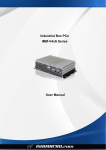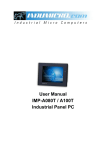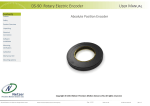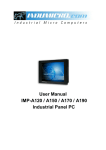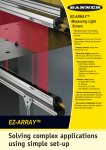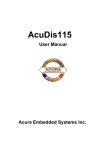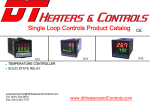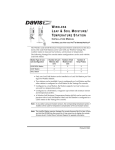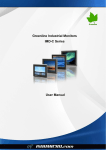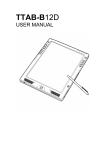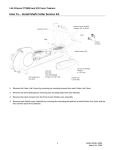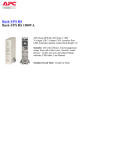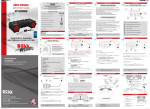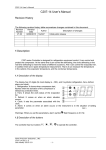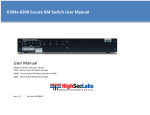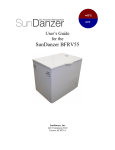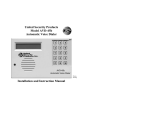Download Indumicro.com IMO-A080(T) User Manual
Transcript
User Manual IMO-A080 Open Frame Monitor ___________________________________ Warning! ___________________________________ This equipment generates, uses and can radiate radio frequency energy and if not installed and used in accordance with the instructions manual may cause interference to radio communications. It has been tested and found to comply with the limits for a Class A computing device pursuant to FCC Rules, which are designed to provide reasonable protection against such interference when operated in a commercial environment. Operation of this equipment in a residential area is likely to cause interference in which case the user at his own expense will be required to take whatever measures may be required to correct the interference. Electric Shock Hazard – Do not operate the machine with its back cover removed. There are dangerous high voltages inside. Disclaimer This information in this document is subject to change without notice. In no event shall Indumicro.com be liable for damages of any kind, whether incidental or consequential, arising from either the use or misuse of information in this document or in any related materials. Table of Contents Chapter 1: Getting Started 1.1 Features…...……………………………………………………….…..…..…1 1.2 Specifications…………………………………………....……………...….1 1.3 Dimensions…………...………………………...………………………….…2 1.4 Brief Description......................................................................................3 1.5 Display Mode………...……………………………………………………….3 Chapter 2: On Screen Display (OSD) 2.1 Back Side Controls……………………………………………….…..…….4 2.2 OSD Controls…………………..……………………………………………..5 2.3 Main Menu …..………..……………………………………………………..6 Chapter 3: Installation 3.1 Configuring PenMount Windows 2000/XP/Vista/7 Driver ……………..6 Chapter 4: Software 4.1 Software Functions………………………………………………………..17 4.2 Software Function Descriptions……………………………………….…18 Chapter 1: Getting Started 1.1 Features ● ● ● ● 8” SVGA color TFT LCD display Optional resistive touch screen Steel chassis OSD on the rear side 1.2 Specifications Display ● ● ● ● ● ● ● ● ● ● Display: 8” SVGA color TFT LCD display Maximum resolution: 800 x 600 Maximum colors: 256K Luminance: 350 cd/m² Viewing angle: 130° /120° (H/V) Backlight life: 40,000 hours OSD control: Yes Touch screen: analog resistive (optional) OS compatibility: Win 95/98, XP, 2000, NT4.0, Vista, 7, QNX, Linux Power Supply: 12V DC @0.9A Mechanical ● ● ● ● ● Construction: steel chassis Input signal: analog RGB OSD on the rear side Dimensions: 208 x 148 x 42mm (W x H x D) Gross Weight: 1.1 kg Environmental ● ● ● ● ● ● Operating temperature: 0 to 50oC (32 to 113oF) Storage temperature: -20 to 60oC (-4 to 140oF) Relative humidity: 10 to 95% @40oC, non-condensing, without touch screen Vibration: 1G peak, 5~500Hz (at random) Shock: 15G peak acceleration (11 msec.duration) EMC: Meet CE, FCC Class A IMO-A080 User Manual 1 Chapter 1: Getting Started Ordering Information IMO-A080 8” SVGA Open frame monitor IMO-A080T 8” SVGA Open frame monitor with resistive touch screen IMO-AOVDC Upgrade to 11~32VDC power input and DVI-D input Option 12V/60W External power adapter Power Connection for IMO-AOVDC 1.3 Dimensions IMO-A080 User Manual 2 Chapter 1: Getting Started 1.4 Brief Description of the IMO-A080 The IMO-A080 open frame monitor features an excellent viewing ability for monitoring and control applications. It is available with resistive touch screen that is easy to use and maintain. Front and back view of the IMO-A080 1.5 Display Mode Display Mode VGA 640 x 480 SVGA 800 x 600 XGA 1024 x 768 1152 x 864 SXGA IMO-A080 User Manual 1280 x 1024 Hori. Sync (KHz) Vert. Sync. (Hz) 31 60 38 72 38 75 35 56 38 60 48 47 72 48 60 56 70 60 75 68 75 64 60 75 80 75 3 Chapter 2: On Screen Display (OSD) 2.1 Back side OSD Functions Auto Adjust Up/Left Down/Right Power Menu/Entry Power Indicator Power switch: To turn ON or OFF the power Shift the icon to the right side or shift it up Shift the icon to the left side or shift it down Menu: To enter OSD menu for related icon and item. Auto Button: One-touch auto adjustment 1.) Getting into Burn-in Mode Before setting into a burn-in mode, first disconnect the AC power cord. Then press (don’t let them go) the buttons until the AC power cord is connected and the “RGB” appears on the top left corner of your screen. Now it can be put into the burn-in mode for changing colors. 2.) Getting Out of Burn-in Mode Before getting out of the burn-in mode, please first disconnect the AC power cord. Then press the button (If not workable, press the button and don’t let them go) until the AC power cord is connected. Please don’t let your fingers go until the AC power cord is connected again and the wording of “RGB” appears on the top left corner of your screen, and wait for 3 seconds. Under the non-signal entry situation, if IMO-A080 User Manual Cable Not Connected is seen, exit is thus successfully made. 4 Chapter 2: On Screen Display (OSD) 2.2 OSD Controls To make any adjustment, select the following: 1. Press (Menu) to show the OSD menu or disable the OSD menu. 2. Select the icon that you wish to adjust with the ( / or +/-) key in the menu. 3. Press (Menu) and then choose the item with the ( 4. Press (Menu) and then adjust the quality with the ( 1.) or +/-) key. / / If the “RGB” is still on the top left corner of the screen, press choose “Reset”, and then Yes, and press or +/-) key. to enter “Miscellaneous” and . When the screen goes black, disconnect power and repeat the above steps. 2.) If the “RGB” is not found, disconnect the AC power cord first. Then press the buttons (don’t let them go) until the AC power cord is connected, and wait for 2 to 3 seconds. When “RGB” appears, repeat the above steps. 3.) Functions of OSD Keys IMO-A080 User Manual 5 Chapter 2: On Screen Display (OSD) 2.3 Main Menu In the Colour menu, there are the following items: z Contrast z Brightness z Gamma Correct z Colour Adjust z Exit For Picture, check out the following: z H. Position: Shifts picture left or right z V. Position: Shifts picture up or down z Sharpness: Fine-tuning of image sharpness z Phase: Allows to fine-tune display quality z Exit For Function, check out the following: z Auto Adjust z Auto Position z Auto Phase z Auto Clock z Auto Colour z Exit IMO-A080 User Manual 6 Chapter 2: On Screen Display (OSD) In the OSD menu, there are the following items: z Language z OSD H. Position z OSD V. Position z OSD Timer z Translucent z Exit For Miscellaneous, check out the following: z Signal Source z Model Select z Reset z Volume z Exit IMO-A080 User Manual 7 Chapter 3: Installation 3.1 Configuring the PenMount Windows 2000/XP/Vista/7 Driver Upon rebooting, the computer automatically finds the new 9036 controller board. The touch screen is connected but not calibrated. Follow the procedures below to carry out calibration. 1. After installation, click the PenMount Monitor icon “PM” in the menu bar. 2. When the PenMount Control Panel appears, click “Calibrate”. PenMount Control Panel The functions of the PenMount Control Panel are Calibrate, Draw, Multiple Monitors, Option, and About, which are explained in the following sections. Calibrate This function offers two ways to calibrate your touch screen. “Standard Calibration” adjusts most touch screens. “Advanced Calibration” adjusts aging touch screens. Standard Calibration Click this button and arrows appear pointing to red squares. Use your finger or stylus to touch the red squares in sequence. After the fifth red point calibration is complete. To skip, press ‘ESC’. Advanced Calibration Advanced Calibration uses 4, 9, 16 or 25 points to effectively calibrate touch panel linearity of aged touch screens. Click this button and touch the red squares in sequence with a stylus. To skip, press ‘ESC’. IMO-A080 User Manual 8 Chapter 3: Installation NOTE: The older the touch screen is, the more Advanced Mode calibration points you need for an accurate calibration. Use a stylus during Advanced Calibration for greater accuracy. IMO-A080 User Manual 9 Chapter 3: Installation Plot Calibration Data IMO-A080 User Manual Check this function and a touch panel linearity comparison graph appears when you have finished Advanced Calibration. The blue lines show linearity before calibration and black lines show linearity after calibration. 10 Chapter 3: Installation Draw Tests or demonstrates the PenMount touch screen operation. The display shows touch location. Click Draw to start. Touch the screen with your finger or a stylus and the drawing screen will register touch activity such as left, right, up, down, pen up, and pen down. Touch the screen with your finger or a stylus and the drawing screen will register touch activity such as left, right, up, down, pen up, and pen down. IMO-A080 User Manual 11 Chapter 3: Installation Click Clear Screen to clear the drawing. Multiple Monitors Multiple Monitors support from 2 to 6 touch screen displays for one system. The PenMount drivers for Windows 2000/XP/Vista/7 support Multiple Monitors. This function supports from 2 to 6 touch screen displays for one system. Each monitor requires its own PenMount touch screen control board, either installed inside the display or in a central unit. The PenMount control boards must be connected to the computer COM ports via the RS-232 interface. Driver installation procedures are the same as for a single monitor. Multiple Monitors support the following modes: Windows Extends Monitor Function Matrox DualHead Multi-Screen Function nVidia nView Function NOTE: The Multiple Monitor function is for use with multiple displays only. Do not use this function if you have only one touch screen display. Please note once you turn on this function the rotating function is disabled. IMO-A080 User Manual 12 Chapter 3: Installation Enable the multiple display function as follows: 1. Check the Enable Multiple Monitor Support box; then click Map Touch Screens to assign touch controllers to displays. 2. When the mapping screen message appears, click OK. IMO-A080 User Manual 13 Chapter 3: Installation 3. Touch each screen as it displays “Please touch this monitor”. Following this sequence and touching each screen is called mapping the touch screens. 4. Touching all screens completes the mapping and the desktop reappears on the monitors. 5. Select a display and execute the “Calibration” function. A message to start calibration appears. Click OK. 6. “Touch this screen to start its calibration” appears on one of the screens. Touch the screen. 7. “Touch the red square” messages appear. Touch the red squares in sequence. 8. Continue calibration for each monitor by clicking Standard Calibration and touching the red squares. NOTES: 1. If you use a single VGA output for multiple monitors, please do not use the Multiple Monitor function. Just follow the regular procedure for calibration on each of your desktop monitors. 2. The Rotating function is disabled if you use the Multiple Monitor function. 3. If you change the resolution of display or screen address, you have to redo Map Touch Screens, so the system understands where the displays are. IMO-A080 User Manual 14 Chapter 3: Installation About This panel displays information about the PenMount controller and this driver version. PenMount Monitor Menu Icon The PenMount monitor icon (PM) appears in the menu bar of Windows 2000/XP system when you turn on the PenMount Monitor in the PenMount Utilities. The PenMount Monitor has the following functions: Beep IMO-A080 User Manual Turns beep on or off. 15 Chapter 3: Installation Right Button When you select this function, a mouse icon appears in the right-bottom of the screen. Click this icon to switch between Right and Left Button functions. Pen Stabilizer Check this function to reduce cursor vibration for relatively unstable touch screens, or where there may be excess vibration. Normally this function is not checked. Exit Exits the PenMount Monitor function. PenMount Rotation Functions There are currently a number of software packages on the market that support rotating monitors 0°, 90°, 180°, and 270°. However you will not be able to use a touchscreen unless it is matched to the appropriate rotation. Our rotation configuration function allows you to easily match the touchscreen when you rotate your monitor. If you use a rotating monitor you will need a display card such as from nVidia, Intel, SMI or ATI and software such as Portrait Pivot Pro. For software operation and features, please refer to your software manual. Configuring the rotation function is easy. Select this option and a ‘point’ appears for you to touch. Once the point is touched the software driver understands which degree you plan to rotate your display. The rotation function supports 90, 180 and 270 degree rotation. NOTE: The rotating function is disabled if you use Monitor Mapping IMO-A080 User Manual 16 Chapter 4: Software 4.1 Software Functions This chapter describes the special software functions that configure and adjust the PenMount controller board and touch screen hardware. Please note that not all of the functions are available for every driver. Software functions and their availability for specific interface and systems are shown in the table below—a description for each function follows: Software Function DOS Win 3.1 95 98/ME NT 2000/XP VISTA/7 CE Linux QNX ● /2003/ Standard Calibration ● ● ● Advanced Calibration ● ● ● ● ● ● ● ● ● ● ● ● Multiple Monitors ● Multi Device ● ● Rotation Operation Mode ● ● ● ● ● Drawing mode ● ● ● ● ● ● Beep Sound ● ● ● ● ● ● Beep sound adjustable ● ● ● ● ● ● Showing linearity ● ● ● Hide cursor ● ● ● ● ● ● ● ● ● ● ● Double click area and speed adjustable About ● ● ● ● ● ● ● ● ● Wake up function Right button ● ● ● ● ● Edge Compenstation ● ● Refresh ● ● Note: With PenMount Windows Universal V2.2.0.283 and later versions, the touchscreen is automatically installed as a digitizer device in Windows Vista/7, the functions which are built within Windows Vista / 7 such as rotation, multi-monitors, flicks, and context menu function (which launches a context menu by user’s long-pressing on touchscreen rather than clicking the right-mouse button or pressing the application key on the keyboard) will be supported. IMO-A080 User Manual 17 Chapter 4: Software 4.2 Software Function Description Description for each of the software functions shown in the table above follows: Standard Calibration The Standard Calibration function lets you match the touch screen to your display so that the point you touch is accurately tracked on screen. Standard calibration only requires four points for calibration and one point for confirmation. Under normal circumstances, Standard Calibration is all you need to perform an accurate calibration. Advanced Calibration The Advanced Calibration function improves the accuracy of calibration by using more involved engineering calculations. Use this function only if you have tried the Standard Calibration and there is still a discrepancy in the way the touch screen maps to the display. You can choose 4, 9, 16 or 25 points to calibrate, though we suggest that you first try 9 points, if it is still not tracking well then try 16 or 25 points. The more points you use for calibration, the greater the accuracy. Errors in calibration may occur due to viewing angle, or individual skill, and there may be little difference in using 16 or 25 points. Note that a stylus is recommended for the most accurate results. Multiple Monitors Until now most touch screen systems only support one monitor, and users of multiple monitors have not been able to use touch screen systems. This situation has inspired PenMount to design and develop Multiple Monitors support using the PenMount 9036 control board and Windows 2000/XP/Vista/7 driver. Our advanced design supports from 2 to 6 monitors that can be split horizontally or vertically. Requirements Before using the Multiple Monitor function, you need the following: 1. A display card that supports multiple monitors such as the Matrox, nVidia, ATI, etc. (Two or more display cards supported by Windows are also OK.) 2. Two or more touch screens 3. Two or more serial ports Before using Multiple Monitors you must have two or more monitors that are in extension mode. For display cards that support multiple monitors, we suggest you consider Matrox, nVidia, or ATI cards and inquire about operation and usability issues. Note: Before you can use multiple monitors, you need to map each monitor. IMO-A080 User Manual 18 Chapter 4: Software Multiple Devices The Multiple Devices function is designed to let you use two or more monitors to display the same image. Comparing Functions The difference between the Multiple Monitors function and the Multiple Devices function are illustrated below: or The Multiple Monitors function shown above extends the screen into 2 or more monitors. The Multiple Devices function displays the same image on two or more monitors. IMO-A080 User Manual 19 Chapter 4: Software Requirements Before using the Multiple Monitors function, you need the following: 1. A display card that supports Dual Monitors such as the Matrox, nVidia, ATI, etc., or that outputs into a 1-into-2 VGA signal box 2. Two or more touch screens 3. Two or more serial ports or USB ports 9000 Control Boards To use multiple devices with 9000 Control Boards: 1. Configure your computer hardware. 2. Attach each 9000 Control Board to a different computer’s serial port. 3. Install the appropriate PenMount software driver in each computer. 4. Use each driver’s Calibration function to calibrate each computer’s touch screen. You must calibrate each touch screen before configuration is complete. Rotation There are currently a number of software packages on the market that support rotating monitors 0°, 90°, 180°, and 270°. However, you will not be able to use a touch screen unless it is matched to the appropriate rotation. Our rotation configuration function allows you to easily match the touch screen when you rotate your monitor. If you use a rotating monitor, you will need a display card such as from nVidia, Intel, MSI or ATI and software such as Portrait Pivot Pro. For software operation and features, please refer to your software manual. Configuring the rotation function is easy. Select this option and a ‘point’ appears for you to touch. Once the point is touched, the software driver understands which degree you plan to rotate your display. The rotation function supports 90, 180 and 270 degrees rotation. IMO-A080 User Manual 20 Chapter 4: Software 0 degrees 90 degrees 180 degrees IMO-A080 User Manual 21 Chapter 4: Software 270 degrees Stream/Point Mode Stream and point modes control the touch and drag function of the touch screen. The point mode only allows “touch” interaction with the screen and does not allow the user to drag objects. The point mode is useful for maintaining the location of screen icons such on POS terminals. The stream mode allows a user to touch and drag icons and other items around on the screen, similar to using a mouse. Drawing Mode Drawing mode is a utility that lets the user draw on the screen using a finger or stylus. This allows the user to test the touch screen and touch controller to see if it is operational or is mapped correctly. The drawing mode can display either the matrix address of points touched or just show lines drawn. One of the PenMount driver’s strengths is a special mathematical algorithm that minimizes the occurrence of noise and smooths the drawing of lines. Beep Sound All of PenMount’s drivers support the beep sound function; however, some PC systems may only offer a fixed buzzer sound. Beep Sound Adjustable Software drivers for Windows systems let the user adjust the frequency and length of the beep sound. The drivers let the user adjust the desired touch screen sound, as well as turn the sound off. IMO-A080 User Manual 22 Chapter 4: Software Wake Up Function The Wake Up function lets the user touch the screen and wake the system up from ‘suspend’ mode. Point Calibration Data The Plot Calibration Data function displays the touch screen linearity map, which is available if the PenMount driver provides an Advance Calibration function when touch screens age their touch linearity declines. This non-linearity is apparent when the touched point on the touch screen is not the same as the point on the display. The plot calibration data function shows the linearity status of the touch screen. This is only a support function for the user. The exact linearity of a touch screen requires a linearity test machine. Right Button The Right Button function simulates the right button function of a mouse. Click the right button and the user can only touch the screen once and the driver changes the touch definition to the left button. Hide Cursor The Hide Cursor function keeps the cursor arrow and other cursor symbols from appearing when using the touch screen. The cursor appears when the user turns this function off. Cursor Offset The Cursor Offset function lets the user adjust the position of the touch point to a desired location away from the real touch point. Double-Click Area and Speed The Double-Click Area and Speed function lets the user adjust the double-click area and speed to their personal preference. About This option shows the exact version of the drivers and controller firmware. Updated drivers are available for download on the PenMount website. IMO-A080 User Manual 23 This page intentionally left blank. Indumicro.com The Netherlands Phone +31 318 668 912 www.indumicro.com [email protected] Edition 1.2 ©Indumicro.com




























